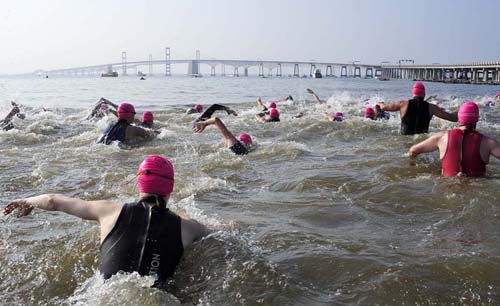More than 600 swimmers from around the country plunged into the water for the 4.4-mile event. (News21 photo by Jason Lenhart; more photos on Flickr)
By Kate Yanchulis
News21
SANDY POINT STATE PARK, Md. - Hundreds of swimmers from across the country churned through the waters of the Chesapeake Bay this morning, and for the participants of the Great Chesapeake Bay Swim, nature cooperated.
The favorable conditions – the water at a balmy 74 degrees, the sun shining, the currents flowing toward the finish line – allowed all but 21 of the 618 swimmers to finish the 4.4-mile charity marathon, said Director Chuck Nabit. Last year, strong currents prevented more than 100 swimmers from completing the race.
Andrew Gyenis, a 15-year-old from Reston, Va., won in a sprint to the finish in a fast 1:28:45.
“I just love open water,” Gyenis said. “Open water has always been my passion, but there [are] not too many options out here for open water. I know this one is famous, so I just wanted to try it and give it a go.”
The rising junior at Georgetown Preparatory School, who swims for Curl-Burke Swim Club, beat out Taylor Smith, 18, from Arnold, Md., by two seconds to win his first open saltwater event. Brian Benda, 39, from Parkton, Md., and Bruce Brockschmidt, 43, from Mount Laurel, N.J., rounded out the top four.
The annual swim set a scenic course through local landmarks. The competition started at Sandy Point State Park and ran east beneath the twin spans of the Chesapeake Bay Bridge before ending on the shore near Hemingway’s Restaurant at the Bay Bridge Marina.
While many participated for the sheer physical challenge, others also saw it as a showcase of the region’s natural treasure, which has attracted millions of dollars in cleanup funds in recent decades in response to declining populations of aquatic life, including crabs and oysters.
“This is like home for us,” Gyenis said of the Chesapeake. “We need to preserve this. I think this is pretty amazing.”
The water looked clean on the surface, and some of the participants were pleasantly surprised by the quality of the water. Dr. Bill Dennison, vice president for science applications at the University of Maryland Center for Environmental Science, said the water quality was the best it has been in several years.
But about a third of the course actually crossed a “dead zone,” or an area of the water with little to no oxygen, making it hostile to aquatic life.
The dead zone stretches 90 to 125 miles long and six miles wide every summer, according to Dr. Mike Roman, lab director at the University of Maryland Center for Environmental Science. That comes to about 10 percent to 15 percent of the total volume of water in the bay, as pollution from nutrients such as nitrogen and phosphorous causes huge algae blooms, which take almost all the oxygen out of the water.
“I was not aware that there was a dead zone, per se,” said Burdi Mahoney, 48, from Richmond, Va., one of those who praised the water’s apparent cleanliness. “But you can definitely feel as you’re swimming, differences in the bay, especially when you’re crossing that shipping channel.”
Organizers cite increased recognition of the bay as one of the main goals of the charity swim, which raises funds for the Chesapeake Bay Trust and other area nonprofit organizations, particularly the local chapter of the March of Dimes.
Though the official event is just 19 years old, it traces its origins to Brian Earley, who swam solo across the bay in 1982 in memory of his father, who had died of diabetes the year before. The mission has morphed since then.
“I think it’s gone from more of helping folks with disability, now through the March of Dimes, to protecting the Chesapeake for generations to come,” said Earley, who now lives in San Diego, Calif., but returns every year for the swim.
“If 100 years from now the Chesapeake is as beautiful and as clean as it can be, then we’re doing our job,” he said.
Earley said he is glad his event can help people discover more about the Chesapeake and become invested in the water.
“I’m so happy to share this event with so many people from around the country, Earley said. “All these folks here, everybody pitching in to honor the Chesapeake, it’s overwhelming.”
This story was produced by the News21 team at the University of Maryland's Philip Merrill College of Journalism, in partnership with Capital News Service. News21’s Sharon Behn contributed to this report. News21 is funded by the John S. and James L. Knight Foundation and the Carnegie Corp.




